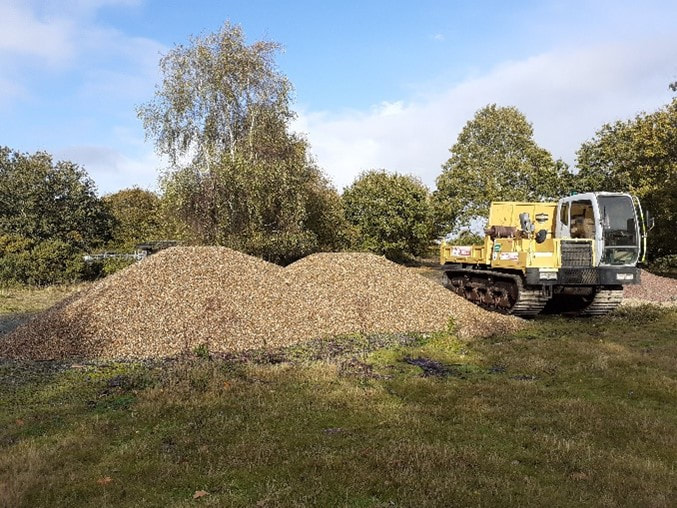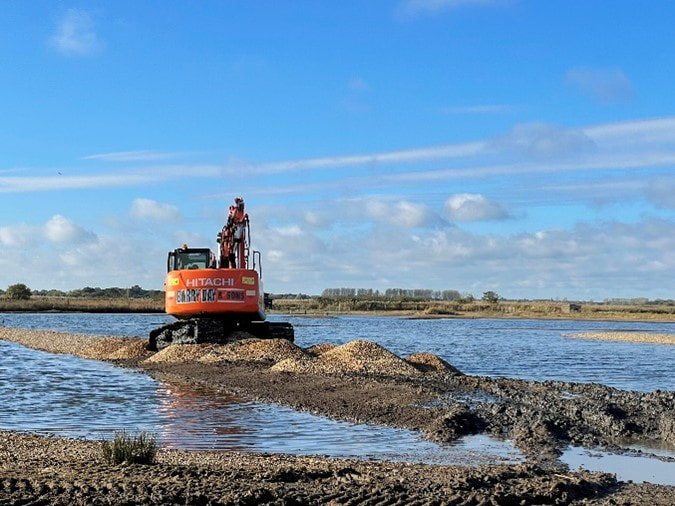|
By Annette Salkeld, RSPB North Suffolk Coast Reserves Warden An exciting three-year project is currently underway to rejuvenate the iconic Minsmere Scrape to benefit breeding, passage and overwintering birds and to improve viewing opportunities. Drone footage of before the works by Jeff Kew The Scrape was originally created in the 1960s as a series of both brackish and freshwater lagoons with islands and remains so to this day. Much work is needed to keep the Scrape in top condition and this project will give us the opportunity to make a big impression. The project has been made possible through funding from the EU Life+ project and the National Grid Landscape Enhancement Initiative. The first year’s work, which involved adding shingle to islands in front of Public Platform, has been completed and is looking fantastic. This will provide nesting habitat for ground nesting shingle loving birds, including little, Sandwich and common terns. The beach at Minsmere used to support breeding little tern, but, as a result of coastal change along the East Anglian coastline, it has been eroding and is no longer a suitable nesting habitat for these endangered birds which stopped using it as a breeding site nearly 15 years ago. It is hoped that by providing alternative habitat on the Scrape they can be encouraged to breed regularly at Minsmere again. Time lapse of shingle being spread on the island by Lou Chapman The work due to be carried out in years two and three (autumn 2022 and 2023) focus in on East Scrape and West Scrape in turn. The aim of this part of the project is to create new, improved islands, as well as changing the layout of the lagoons by removing or building up the dividing bunds. An area of encroaching reeds will also be removed which in turn will increase the area of lagoon habitat. By doing this we will improve the islands for breeding birds as well as maximising the views of the birds from the hides. Rejuvenation of the lagoons will also ensure that the Scrape remains a mecca for passage waders: 52 species have been recorded at Minsmere with an average of 32 species visiting each year.
New water control structures will be installed to enhance hydrological management, enabling us to run the lagoons at different water depths and improving our ability to move water around the site. This is particularly important in flood and drought conditions. The work should also benefit the iconic avocet which was the target of the original Scrape creation project and remains a top priority and visitor attraction. The timing is perfect as we celebrate the 75th anniversary of the reserve this year! The RSPB Minsmere Facebook and Twitter accounts will be kept updated with progress on this fascinating project so why don’t you connect with Minsmere through social media and keep informed on the great work happening on the reserve.
3 Comments
dj1
15/2/2022 18:44:06
I'd take minor issue with a couple of things in this article.
Reply
IDB71
16/2/2022 12:00:09
When the avocets nested in 1947, they did so on pools left over form wartime flooding, but these were in front of what is now Bittern Hide, not where the Scrape now is. Those pools subsequently developed into reedbed, and the Scrape was first created by Bert Axell in the early 1962s, when avocet returned to breed for a second time. The Scrape has been enlarged and carefully managed ever since.
Reply
Gill Taylor
15/2/2022 19:51:07
Congratulations. This project recognises the international significance of Minsmere as a unique set of habitats. It will go a long way to securing the future of the reserve and its diverse bird population in particular. I was a nipper and Mum on the committee when Bert Axell was working at Dungeness. After he moved to become warden at Minsmere in 1959 we spent many family holidays as his guests. I well remember “Uncle” Bert, his son, Ricky, assistant wardens and volunteers using a combination of brain and brawn to developed the Scrape. The system of sluices both intrigued me and held me in thrall. There was a lot of heavy tractor and spade work involved plus a great deal of mud as I recall! “Auntie” Joan’s and Mum’s culinary skills were called on daily to feed the troops back at the bungalow! It was a real adventure and particularly exciting to see my first ever avocet back then. Happy memories and much more importantly a thrill to know the Scrape lives on as a dynamic entity to anticipate, protect and provide for future wildlife needs.
Reply
Leave a Reply. |
Archives
April 2024
Categories
All
Photo credits: Oystercatcher by Katie Nethercoat (rspb-images.com)
LOTE Logo credits: Saskia Wischnewski |



